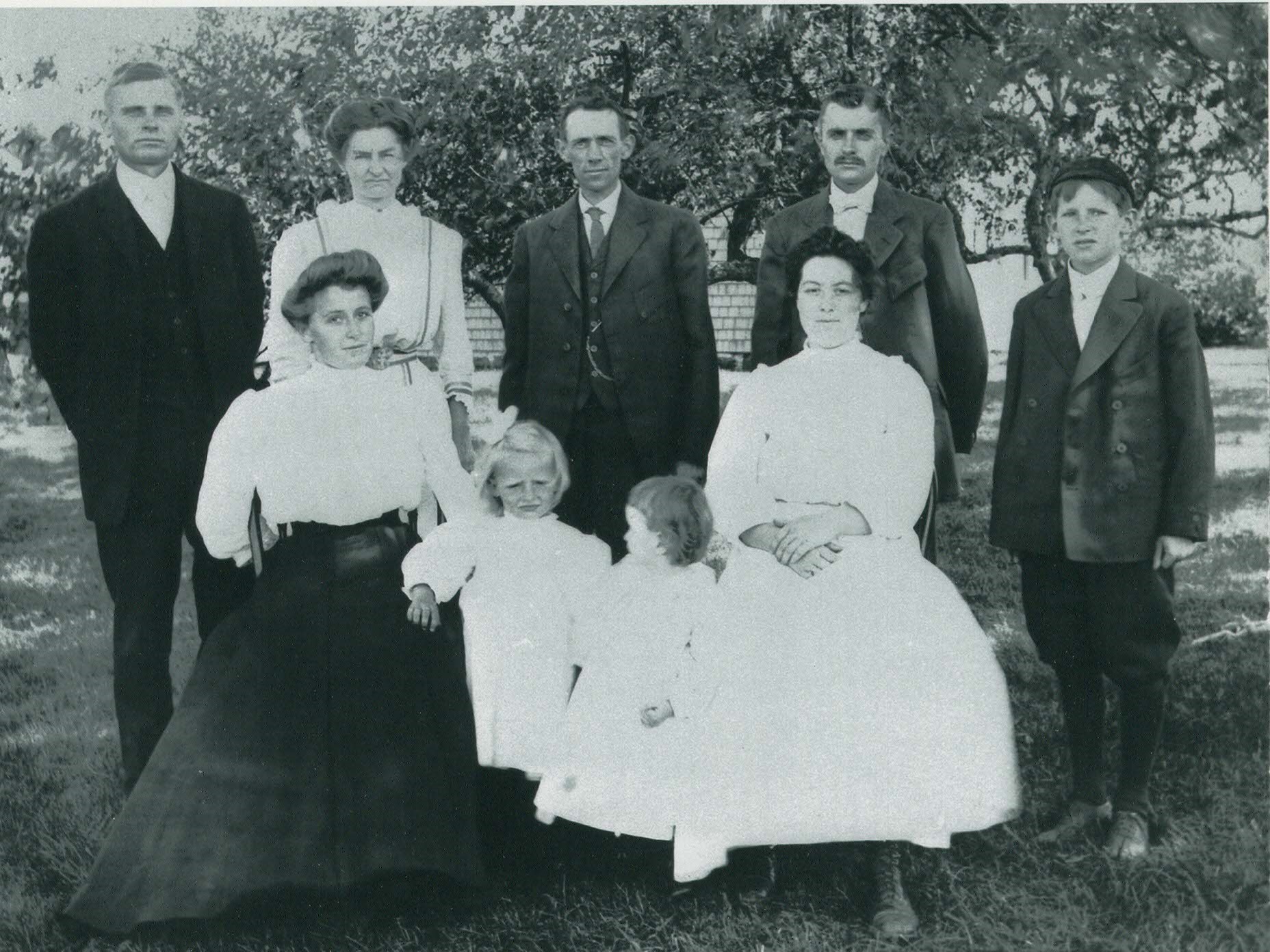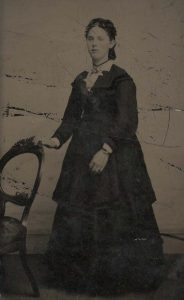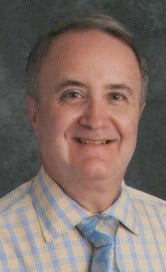 Front, left to right: Mary (Kleeb) Morse, wife of Albert; her daughter, Emily, known as “Sunshine”; Emory Morse, my grandfather; Myrta (Pierce) Morse, Emory’s mother, wife of Millard. Standing: Albert Burgess Morse; his sister, Edith (Morse) Nickerson; her husband, Levi Curtis “Curt” Nickerson, Millard Emory Morse; and Kenneth Wesley Nickerson, age 10, son of Edith and Curt.
Front, left to right: Mary (Kleeb) Morse, wife of Albert; her daughter, Emily, known as “Sunshine”; Emory Morse, my grandfather; Myrta (Pierce) Morse, Emory’s mother, wife of Millard. Standing: Albert Burgess Morse; his sister, Edith (Morse) Nickerson; her husband, Levi Curtis “Curt” Nickerson, Millard Emory Morse; and Kenneth Wesley Nickerson, age 10, son of Edith and Curt.
My grandfather and his cousin Emily (Morse) (Rees) Wetherbee (1906–1964), lovingly known as “Sunshine,” remained close throughout her life. Their fondness for one another is already evident in this family photo, taken in July 1909.
“Sunshine,” given the name Emily for her paternal grandmother, Emily Clapp (Waters) Morse (1855–1896), became the conduit through which remembered ties to Governor William Bradford of Plymouth Colony passed to me. The Waters family had never forgotten their link to the Mayflower. William Bradford’s grandson Elisha Bradford, in his sixties, fathered two daughters, Alice and Asenath Bradford. Alice married in 1757 Zebulon Waters of Stoughton. Their son, Asa Waters (1760–1845), who styled himself a captain after his Revolutionary War service, kept detailed genealogical records. His son, Lewis Waters (1791–1857) married his second cousin, Julia Randall (1798–1881), Asenath Bradford’s granddaughter.
 Lewis Waters Jr. (1822–1892) of Wareham assuredly had a sense of history in naming two of his children William Bradford and Alice Bradford Waters. Lewis Jr.’s daughter Emily (Waters) Morse, pictured here in a tintype taken around 1875, did not live to see any grandchildren, but her sister Julia Randall (Waters) Morse (1865–1941) found a dutiful listener in her great-niece Sunshine. In turn, Sunshine, several years before her death, made a Bradford/Waters genealogical outline for my grandfather, who kept this yellowed paper in a cubbyhole in his slant-top secretary desk. She wrote, “I was only a child when I took it down [from Aunt Julia] so may be inaccurate.” It wasn’t!
Lewis Waters Jr. (1822–1892) of Wareham assuredly had a sense of history in naming two of his children William Bradford and Alice Bradford Waters. Lewis Jr.’s daughter Emily (Waters) Morse, pictured here in a tintype taken around 1875, did not live to see any grandchildren, but her sister Julia Randall (Waters) Morse (1865–1941) found a dutiful listener in her great-niece Sunshine. In turn, Sunshine, several years before her death, made a Bradford/Waters genealogical outline for my grandfather, who kept this yellowed paper in a cubbyhole in his slant-top secretary desk. She wrote, “I was only a child when I took it down [from Aunt Julia] so may be inaccurate.” It wasn’t!
Twenty years later, when my grandfather handed me Sunshine’s sketch, I felt compelled to “do something” with this exciting information. It took me only two weeks to assemble the documentation necessary to join the General Society of Descendants through a lineage to William Bradford.[1] This rewarding experience became almost addicting in seeking more Mayflower ancestors hidden among twelve generations of my maternal families who remained in Plymouth or Barnstable Counties. While proving some Mayflower lines was accomplished by accessing books on library shelves, other quests evolved into hard-won research discoveries, especially before internet access.
For example, Levi Fish (1754–1837), buried in the Morse lot at Woodside Cemetery in Rochester, Massachusetts, did not have his marriage or children recorded in Sandwich town records. Russell Lovell, Sandwich archivist in 1985, facilitated my discovery of Levi’s marriage to Sarah Cobb, recorded in Benjamin Percival’s diary, later published as part of Sandwich Vital Records.
Mayflower passengers continue to exert their hold me, especially when they seem to be hidden in plain sight.
Working through Levi and Sarah’s ancestors, I added Mayflower passengers Thomas Rogers, Stephen Hopkins, John Howland, and Edward Fuller as supplements to my Bradford lineage. And so on. Altogether, I have documented about 30 lines to a dozen Mayflower passengers. Over the last thirty-five years, it usually provides a chuckle in the audience of Mayflower Society meetings at how many times I get to stand or raise my hand during the roll call of ancestors. Enrolling my mother and grandfather in the Vermont Society of Mayflower Descendants inspired Sunshine’s daughters and grandchildren to join the Society as well, and, thus, Sunshine’s efforts in preserving family ties has come full circle.
Avid genealogists never sit on their laurels. Mayflower passengers continue to exert their hold me, especially when they seem to be hidden in plain sight. Take this tantalizing mystery: Who was Betsy Doty of Plymouth, who married Ebenezer Besse of Wareham on 26 September 1776? That question still perplexes researchers! She does not seem to fit in the well-studied Doty/Doten families, descendants of Edward Doty. One possibility I am still exploring: Was Betsy a young widow – Elizabeth Churchill, whose marriage intention to Paul Doten Jr. was published in Plymouth on 5 November 1774? Perhaps Betsy’s identity may be solved one day with the help of DNA evidence.
As the quatercentenary of the Mayflower landing approaches, what I do contemplate? Counting Pilgrims among my forebears inspires me to reflect the full panoply of American history from 1620 [and before] to the present. I often reflect on my other immigrant ancestors who were not the right group in the right place at the right time to have their lives so richly recorded. That’s the fabric of America. The diversity of my heritage, with the acquired knowledge of those who have gone before me, has immeasurably enriched my life.
Note
[1] I served as State Historian for the Vermont Society of Mayflower Descendants from 1986 to 1996, and as Governor from 1996 to 1999.
Share this:

About Michael Dwyer
Michael F. Dwyer first joined NEHGS on a student membership. A Fellow of the American Society of Genealogists, he writes a bimonthly column on Lost Names in Vermont—French Canadian names that have been changed. His articles have been published in the Register, American Ancestors, The American Genealogist, The Maine Genealogist, and Rhode Island Roots, among others. The Vermont Department of Education's 2004 Teacher of the Year, Michael retired in June 2018 after 35 years of teaching subjects he loves—English and history.View all posts by Michael Dwyer →